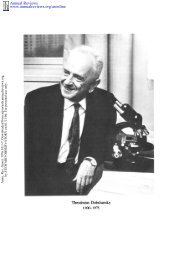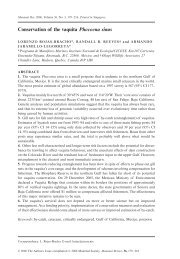Dumont et al. 2006 - The Department of Ecology and Evolutionary ...
Dumont et al. 2006 - The Department of Ecology and Evolutionary ...
Dumont et al. 2006 - The Department of Ecology and Evolutionary ...
You also want an ePaper? Increase the reach of your titles
YUMPU automatically turns print PDFs into web optimized ePapers that Google loves.
1246 M. G. <strong>Dumont</strong> <strong>et</strong> <strong>al</strong>.the soil clone <strong>and</strong> therefore the position <strong>of</strong> the mptG geneon this clone from an uncultivated M<strong>et</strong>hylocystis sp. isunusu<strong>al</strong>. Within the genome <strong>of</strong> M<strong>et</strong>hylococcus capsulatus(Bath) (AE017282), the mptG gene is <strong>al</strong>so positioned inclose proximity to a pmoCAB operon, but is separated byfour genes, fhcC, fhcD, fhcA <strong>and</strong> fhcB, that encode subunits<strong>of</strong> the formyltransferase/hydrolase complex for C 1transfer.In summary, the r<strong>et</strong>riev<strong>al</strong> <strong>of</strong> SIP-generated 13 C-DNAfrom environment<strong>al</strong> samples provides access to thegenomes <strong>of</strong> bacteria in the environment that were involvedin specific m<strong>et</strong>abolic processes. As shown in this study,the genes encoding m<strong>et</strong>abolic pathways are <strong>of</strong>ten linkedon chromosomes <strong>and</strong> therefore it is possible by combiningDNA-SIP <strong>and</strong> m<strong>et</strong>agenomics to r<strong>et</strong>rieve targ<strong>et</strong>ed gen<strong>et</strong>icinformation with minim<strong>al</strong> sequencing effort. With continuedadvances in genomics <strong>and</strong> DNA sequence an<strong>al</strong>ysis,it may soon become more feasible to reconstruct thecompl<strong>et</strong>e genomes <strong>of</strong> microbi<strong>al</strong> populations <strong>and</strong> consortiadirectly from the environment (Venter <strong>et</strong> <strong>al</strong>., 2004). Untilnow, m<strong>et</strong>agenomic studies have been largely restricted tothe most abundant organisms in the community, but DNA-SIP <strong>of</strong>fers a breakthrough means by which ecologic<strong>al</strong>lyrelevant, <strong>and</strong> potenti<strong>al</strong>ly subdominant, community membersmay be characterized <strong>and</strong> their m<strong>et</strong>abolic functionsreve<strong>al</strong>ed.Experiment<strong>al</strong> proceduresSoil sampling <strong>and</strong> SIP<strong>The</strong> characteristics <strong>of</strong> the Gisburn forest soil were describedpreviously (Radajewski <strong>et</strong> <strong>al</strong>., 2002). Soil was collected inAugust 2002 <strong>and</strong> SIP experiments were performed essenti<strong>al</strong>lyas described previously (Radajewski <strong>et</strong> <strong>al</strong>., 2002).Briefly, a soil slurry was made by adding 10 ml <strong>of</strong> ANMSmedium (NMS medium (Whittenbury <strong>et</strong> <strong>al</strong>., 1970) containing0.5 g NH 4 Cl, 0.5 g KNO 3 <strong>and</strong> buffered with 4 mM phosphate,pH 3.5) to 5 g <strong>of</strong> soil. <strong>The</strong> slurry was incubated in a 125 mlserum vi<strong>al</strong> se<strong>al</strong>ed with a butyl stopper on a rotary shaker(∼100 rpm) at room temperature (20–25°C) <strong>and</strong> in the dark.<strong>The</strong> soil DNA was harvested after consumption <strong>of</strong> a tot<strong>al</strong> <strong>of</strong>50 ml <strong>of</strong> 13 CH 4 (Linde) added in 10 ml <strong>al</strong>iquots to the soilslurry microcosm (Radajewski <strong>et</strong> <strong>al</strong>., 2002). <strong>The</strong> headspacewas flushed with air b<strong>et</strong>ween injections to limit theaccumulation <strong>of</strong> 13 CO 2 from compl<strong>et</strong>e oxidation <strong>of</strong> 13 CH 4 bym<strong>et</strong>hanotrophs.DNA extraction from soil<strong>The</strong> protocol for DNA extraction from soil was based on them<strong>et</strong>hod previously described (Zhou <strong>et</strong> <strong>al</strong>., 1996), with sever<strong>al</strong>modifications. <strong>The</strong> soil slurry was placed in a 35 ml Oakridg<strong>et</strong>ube <strong>and</strong> centrifuged at 6000 g in a JA20 rotor. <strong>The</strong> soil pell<strong>et</strong>was suspended in 13.5 ml <strong>of</strong> extraction buffer [100 mM Tris-HCl (pH 8.0), 100 mM sodium EDTA (pH 8.0), 100 mMsodium phosphate (pH 8.0), 1.5 M NaCl, 1% (w/v) CTAB] towhich 100 µl <strong>of</strong> fresh Proteinase K (10 mg ml −1 ) was added.<strong>The</strong> tube was placed horizont<strong>al</strong>ly on a 200 rpm shaker at37°C for 30 min. 1.5 ml <strong>of</strong> 20% (w/v) SDS was added <strong>and</strong>the tube was placed at 65°C for 2 h <strong>and</strong> mixed by inversionevery 15 min. <strong>The</strong> supernatant was decanted into a cleantube after centrifugation for 10 min at 6000 g at 25°C. <strong>The</strong>soil pell<strong>et</strong> was again suspended in 4.5 ml <strong>of</strong> extraction buffer<strong>and</strong> 0.5 ml <strong>of</strong> 20% (w/v) SDS, incubated at 65°C, centrifugedas before <strong>and</strong> the supernatant added to the first <strong>al</strong>iquot. <strong>The</strong>crude extract (∼20 ml) was gently extracted with chlor<strong>of</strong>orm[containing 4% (v/v) isoamyl <strong>al</strong>cohol to minimize foaming]<strong>and</strong> centrifuged at 16 000 g for 10 min at 25°C. <strong>The</strong> aqueousphase was transferred to a clean tube with a wide bore 5 mlpip<strong>et</strong>te tip, made by cutting ∼5 mm from the tip end. Care wastaken to leave the interface undisturbed. <strong>The</strong> DNA was precipitatedfrom the aqueous phase by adding 0.6 vol.(∼10.5 ml) <strong>of</strong> 2-propanol, mixing gently <strong>and</strong> incubating for 1 hat room temperature. <strong>The</strong> DNA was pell<strong>et</strong>ed by centrifugationat 16 000 g for 20 min at 20°C. <strong>The</strong> DNA pell<strong>et</strong> was rinsedwith 5 ml <strong>of</strong> 70% (v/v) <strong>et</strong>hanol <strong>and</strong> air-dried for 20 min.UltracentrifugationTot<strong>al</strong> DNA from the extraction was dissolved in 20 ml <strong>of</strong> TEbuffer (Sambrook <strong>and</strong> Russell, 2001) at 4°C for 16 h. <strong>The</strong>volume <strong>of</strong> DNA solution was measured <strong>and</strong> exactly 1 g ml −1CsCl was dissolved by gentle mixing. Five hundred microlitres<strong>of</strong> <strong>et</strong>hidium bromide (10 mg ml −1 ) was added <strong>and</strong> thesolution transferred to a 25 mm × 89 mm poly<strong>al</strong>lomer Quick-Se<strong>al</strong> ultracentrifuge tube (Beckman). Unfilled tube volumewas filled by adding 1 g ml −1 CsCl in TE buffer. <strong>The</strong> tube wascentrifuged at 180 000 g (45 000 rpm) for 20 h. If the position<strong>of</strong> the DNA in the gradient could not be seen in visible light,the tube was exposed to long wavelength UV (365 nm) for aminimum time (< 2 s); it was found that indiscriminate UVexposure subsequently made it impossible to clone the DNA.<strong>The</strong> portion <strong>of</strong> gradient containing the DNA was collectedusing a 16-gauge needle <strong>and</strong> 2.5 ml syringe (Sambrook <strong>and</strong>Russell, 2001). Another 250 µl <strong>of</strong> <strong>et</strong>hidium bromide(10 mg ml −1 ) was added to the DNA solution, which wastransferred to a new 25 mm × 89 mm Quick-Se<strong>al</strong> tube <strong>and</strong>centrifuged as before. DNA b<strong>and</strong>s were collected with aneedle <strong>and</strong> syringe as before. <strong>The</strong> DNA was then transferredto a 13 mm × 51 mm poly<strong>al</strong>lomer Quick-Se<strong>al</strong> tube <strong>and</strong> centrifugedat 265 000 g (55 000 rpm) in a VTi65 rotor at 20°C.<strong>The</strong> b<strong>and</strong>s were collected independently ( 13 C-DNA followedby 12 C-DNA) <strong>and</strong> each placed in a new 13 mm × 51 mmQuick-Se<strong>al</strong> tube <strong>and</strong> centrifuged as before. <strong>The</strong> repeatedcentrifugations were performed to ensure that the 13 C-DNAwas purified from contaminating 12 C-DNA <strong>and</strong> coextractedsoil organics. Ethidium bromide was removed from DNApreparations by repeated extractions with water-saturated 1-butanol (Sambrook <strong>and</strong> Russell, 2001). <strong>The</strong> CsCl wasremoved by di<strong>al</strong>ysis against TE buffer <strong>and</strong> the DNA stored at4°C.<strong>The</strong> des<strong>al</strong>ted DNA was purified by electrophoresis on a 1%(w/v) low melting point agarose gel in 1× TAE buffer withoutadded <strong>et</strong>hidium bromide. Low melting point agarose (Gibco)was used because it has a large pore size which <strong>al</strong>lows therestriction enzyme to pen<strong>et</strong>rate the agarose plug (Sambrook<strong>and</strong> Russell, 2001). To minimize DNA shearing, 3 mm was© <strong>2006</strong> <strong>The</strong> AuthorsJourn<strong>al</strong> compilation © <strong>2006</strong> Soci<strong>et</strong>y for Applied Microbiology <strong>and</strong> Blackwell Publishing Ltd, Environment<strong>al</strong> Microbiology, 8, 1240–1250




